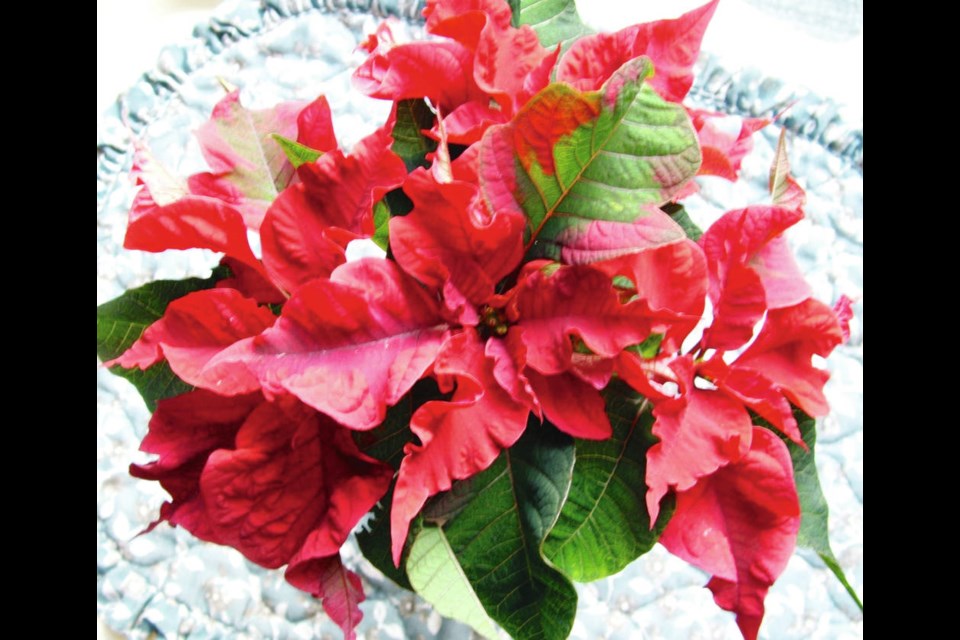Dear Helen: I have a large potted poinsettia. Can I plant it outdoors in a sheltered area? I’ve seen hedges of these plants on Maui.
A.S.
Poinsettias are not hardy outdoors in our climate, but they do benefit from a summer outdoors in filtered light. A poinsettia should not be exposed to temperatures below 13 C. Some people toss the plants out after enjoying them in the house for a while, but they are easy to keep as house plants.
Your poinsettia will remain in top decorative form in a site that offers six hours of bright light daily and even slightly cool room temperatures, ideally not exceeding 22 C during the day, with a drop to around 16 C at night.
Water thoroughly as soon as a top layer of soil dries. Empty excess from the drainage tray. If the pot is encased in decorative foil, tear away the foil at the base of the pot to allow for drainage.
A light misting of the lower leaves will help to raise humidity levels around the plant. Mist early in the day using tepid water, so that the plant does not go damp into the night. Protect poinsettias from hot or cold drafts, which often initiate leaf drop.
In the spring, prune the stems back, making the cuts immediately above new, outward-facing shoots. After pruning, repot into a just slightly wider pot. Or, if the pot is already a large one, replace a top layer of soil with fresh planting mix suitable for house plants.
With the warm spring weather in May, set the plant outdoors in a sheltered spot in dappled sun or light shade.
Keep it well watered, and in early September clean the plant and pot well and bring it back indoors.
You may choose to enjoy your poinsettia simply as an attractive green plant; however, if you want to repeat the fine colouring of the upper bracts for Christmas, the plant will require 10 weeks of 10-hour days. That means placing the plant where lights are not turned on from dusk to dawn, beginning in early October.
Lacking such a place, some people simply set their saved poinsettias in bright natural light, in a room where lights are seldom turned on at night. When I’ve handled my poinsettias this way, I usually get at least some colouring in the bracts.
Dear Helen: When and how do you prune big-leaf hydrangeas?
H.L.
I aim to prune these shrubs between the middle and end of February in most years. This year, because the weather has been so mild, earlier in the month would probably be fine. I remove the old flower stems, making the cuts immediately above a pair of fat growth buds below the old flowers.
At the same time I remove at their point of origin any weak, spindly stems and cut back or remove growth that detracts from the shrubs’ shapeliness.
Dear Helen: What can you tell me about a plant called Dierama? A friend has offered me some of the Dierama seeds she has. Do the plants grow easily from seed? What sort of planting site and care do they need?
C.D.
Dierama is a bulbous perennial easily grown from seed. The species usually grown is Dierama pulcherrimum, the descriptive term meaning “most beautiful.” Common names are wand flower and angel’s fishing rod, for the graceful, arching stems that in summer are hung with showers of bell-shaped flowers, mainly in a range of pink shades.
Plant World Seeds in Britain lists 10 varieties. My seeds from them germinated with no problem last spring. The potted plants have wintered well in a sheltered spot outdoors and will be trimmed back and transplanted into the garden this spring.
Dierama plants thrive in a sunny site with a humus-rich, well-drained soil kept regularly watered in dry weather.
Dear Helen: I read your recent comments on Fremontia shrubs and their fine, irritating hairs. Are the plants deer-proof? How much sun do they need?
S.S.
Fremontia is a California native requiring full sun and a very well-drained soil that is kept only minimally watered once the plant is well established, usually after a year in a garden.
I’ve not seen Fremontia on any of the “deer-resistant” plant lists I’ve come across. The only information I can find on this issue indicates that Fremontia can be vulnerable to deer foraging while the plants are small.
Plants grown to 180 centimetres tall become more resistant, especially if they are watered only occasionally. Caging young plants with wire fencing is recommended.



